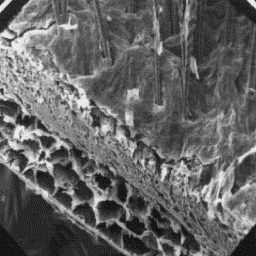 Apodemus sylvaticus
Apodemus sylvaticus
-------------------
English: Wood mouse
German: Waldmaus
French: Mulot silvestre
Spanish: Ratón
Distribution areas
------------------
The wood mouse together with other mouse
varieties has spread with Man into many
geographic areas. The animal originates in
Europe and Central Asia with the exception
of the most northerly regions and at
altitudes higher than 2000 m above sea
level. The surface structure
of the skin, 200x
Description of the fur
----------------------
The skin of the wood mouse is about 20 cm long, with the ringed tail
having short, grey-coloured hairs. The back is grey in colour with
yellow-brownish shades and the belly, together with the ends of the legs, is
white. The winter skins are more distinctly reddish in colour in the hind
parts. The fine fibres of the undercoat layer are dark-grey over the whole;
the variable shades and the white appearance are due to different coloration
of the upper parts of the hairs.
|
|
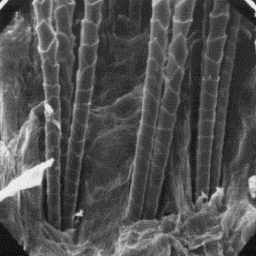 Apodemus sylvaticus
Apodemus sylvaticus
-------------------
English: Wood mouse
German: Waldmaus
French: Mulot silvestre
Spanish: Ratón
The hair coat is dense, consisting of
straight fibres. The length of the under-fur
fibres is about 6 or 8 mm; the longest guard
hairs are from 9 to 13 mm long.
Structure of the hairs
----------------------
The microscopic structure of the skin
surface is furrowed. The upper part of the A group of the fine hairs,
individual hair follicles is in close 600x
contact with the hair shafts and the
follicle edges are at the level of the skin surface. The average follicle
contains two hair shafts.
The fine fur fibres are from 7 to 18 µm in diameter and the cross-sections
are circular or slightly polyhedral in outline. The prevailing cuticular scale
is the raised edge-shaped type; only in the lowest part of the shaft do the
hairs have cornet-like scales. The scales are irregularly grooved on their
surface; the scale margins are smooth or straight.
|
|
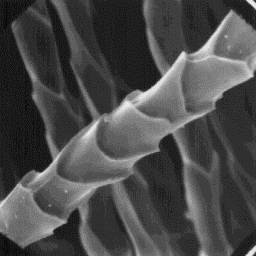 Apodemus sylvaticus
Apodemus sylvaticus
-------------------
English: Wood mouse
German: Waldmaus
French: Mulot silvestre
Spanish: Ratón
The medulla is of the wide type,
longitudinally unbroken, and situated sym-
metrically in the central axial part of the
shaft. The medullar structure is of the
fractured uniserial ladder type, with the
patches divided into two parts in a
horizontal direction. The infilling medullar
substance is granular.
The cuticular structure
The intermediate fibres are similar to of the fine fibres, 1000x
the fine fur fibres but the average
cross-sectional diameter is wider, in the range of 18 to 25 µm. Other micros-
copic structural features are the same as those described for fine fur fibres.
The guard hairs are straight with short, flattened, spear-shaped ends. The
hair shaft is circular in cross-section; only the "spear" is aster-like in
outline. The cross-sectional diameter at the lower part of the shaft is from
20 to 35 µm while that of the flattened tip is about 30 to 70 µm.
|
|
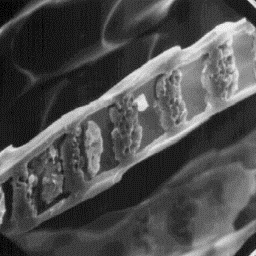 Apodemus sylvaticus
Apodemus sylvaticus
-------------------
English: Wood mouse
German: Waldmaus
French: Mulot silvestre
Spanish: Ratón
The cuticle has rounded tile-like scales
with a smooth surface and straight margins.
The medullar structure is wide, unbroken and
symmetrically situated in the central axial
part of the hair shaft. The overall medullar
structure is of the lumpy type with an
amorphous infilling substance.
Longitudinal section
of a fine fur fibre, 1500x
|
|
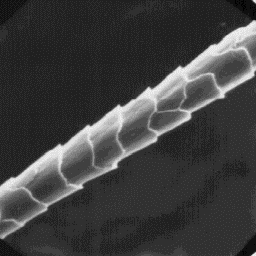 Apodemus sylvaticus
Apodemus sylvaticus
-------------------
English: Wood mouse
German: Waldmaus
French: Mulot silvestre
Spanish: Ratón
The cuticular structure
of the fine fibres, 2000x
Numerical code for wood mouse skin structure
--------------------------------------------
Surface of the skin: 3-4-2
Fine fur fibres: 1-9.5-3-1-2-1-1-3-6-7.18-6.8
Intermediate fibres: 1-9.5-3-1-2-1-1-3-6-18.25-8.11
Guard hairs: 1.7-3-1-1-2-1-1-13-8-20.71-9.13
|




